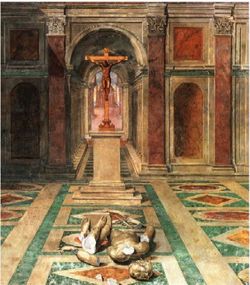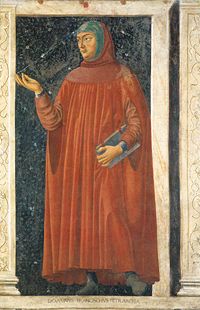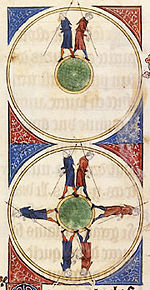Dark Ages
2008/9 Schools Wikipedia Selection. Related subjects: General history
- This article is about the phrase "Dark Age(s)" as a characterization of the (Early) Middle Ages in Western Europe.
In European historiography, the term Dark Age or Dark Ages refers to the Early Middle Ages, the period encompassing (roughly) 476 to 1000 AD.
This concept of a Dark Age was created by the Italian scholar Petrarch ( Francesco Petrarca) in the 1330s and was originally intended as a sweeping criticism of the character of Late Latin literature. Later historians expanded the term to refer to the transitional period between Classical Roman Antiquity and the High Middle Ages, including not only the lack of Latin literature, but also a lack of contemporary written history, general demographic decline, limited building activity and material cultural achievements in general. Popular culture has further expanded on the term as a vehicle to depict the Middle Ages as a time of backwardness, extending its pejorative use and expanding its scope.
The rise of archaeology and other specialties in the 20th century has shed much light on the period and offered a more nuanced understanding of its positive developments. Other terms of periodization have come to the fore: Late Antiquity, the Early Middle Ages, and the Great Migrations, depending on which aspects of culture are being emphasized.
When modern scholarly study of the Middle Ages arose in the 19th century, the term "Dark Ages" was at first kept, with all its critical overtones. When the term "Dark Ages" is used by historians today, it is intended to be neutral, namely, to express the idea that the events of the period often seem "dark" to us only because of the paucity of artistic and cultural output, including historical records, when compared with later times.
Petrarch

It is generally accepted that the concept was created by Petrarch in the 1330s. Writing of those who had come before him, he said, "Amidst the errors there shone forth men of genius, no less keen were their eyes, although they were surrounded by darkness and dense gloom. Christian writers had traditional metaphors of "light versus darkness" to describe "good versus evil". Petrarch was the first to co-opt the metaphor and give it secular meaning by reversing its application. Classical Antiquity, so long considered the "dark" age for its lack of Christianity, was now seen by Petrarch as the age of "light" because of its cultural achievements, while Petrarch's time, lacking such cultural achievements, was seen as the age of darkness.
As an Italian, Petrarch saw the Roman Empire and the classical period as expressions of Italian greatness. He spent much of his time traveling through Europe rediscovering and republishing the classic Latin and Greek texts. He wanted to restore the classical Latin language to its former purity. Humanists saw the preceding 900-year period as a time of stagnation. They saw history unfolding, not along the religious outline of St. Augustine's Six Ages of the World, but in cultural (or secular) terms through the progressive developments of classical ideals, literature, and art.
Petrarch wrote that history had had two periods: the classic period of the Greeks and Romans, followed by a time of darkness, in which he saw himself as still living. Humanists believed one day the Roman Empire would rise again and restore classic cultural purity, and so by the late 14th and early 15th century, humanists such as Leonardo Bruni believed they had attained this new age, and that a third, Modern Age had begun. The age before their own, which Petrarch had labeled dark, thus became a "middle" age between the classic and the modern. The first use of the term "Middle Age" appeared with Flavio Biondo around 1439.
After the Renaissance
Historians prior to the 20th century wrote about the Middle Ages from a mix of perspectives. Most of them expressed negative sentiments.
Reformation
During the Protestant Reformation of the 16th and 17th centuries, Protestants wrote of the Middle Ages as a period of Catholic corruption. Just as Petrarch's writing was not an attack on Christianity per se—in addition to his humanism, he was deeply occupied with the search for God—neither was this an attack on Christianity, but the opposite: it was a drive to restore what Protestants saw as a "purer" Christianity. In response to these attacks, Roman Catholic reformers developed a counter image, depicting the age as a period of social and religious harmony, and not "dark" at all.
Enlightenment
During the 17th and 18th centuries, in the Age of Enlightenment, religion was seen as antithetical to reason. Because the Middle Ages were seen as the "Age of Faith", it was seen as a period contrary to reason, and thus contrary to the Age of Reason. Immanuel Kant and Voltaire were two Enlightenment writers who were vocal in attacking the religiously dominated Middle Ages as a period of social decline. Many modern negative conceptions of the age come from Enlightenment authors. Yet just as Petrarch, seeing himself on the threshold of a "new age", was criticizing the centuries up until his own time, so too were the Enlightenment writers criticizing the centuries up until their own. These extended well after Petrarch's time, since religious domination and conflict were still common into the 17th century and beyond, albeit diminished in scope.
Consequently, an evolution had occurred in at least three ways. Petrarch's original metaphor of light versus dark had been expanded in time, implicitly, at least. Even if the early humanists after him no longer saw themselves living in a dark age, their times were still not light enough for 18th-century writers who saw themselves as living in the real Age of Enlightenment, while the period covered by their own condemnation had been extended and was focused also on what we now call Early Modern times. Additionally, Petrarch's metaphor of darkness, which he used mainly to deplore what he saw as a lack of secular achievements, was sharpened to take on a more explicitly antireligious meaning in light of the draconian tactics of the Catholic clergy.
In spite of this, the term "Middle Ages", used by Biondo and other early humanists after Petrarch, was the name in general use before the 18th century to denote the period up until the Renaissance. The earliest recorded use of the English word "medieval" was in 1827. The term "Dark Ages" was also in use, but by the 18th century, it tended to be confined to the earlier part of this medieval period. Starting and ending dates varied: the Dark Ages were considered by some to start in 410, by others in 476 when there was no longer an emperor in Rome, and to end about 800, at the time of the Carolingian Renaissance under Charlemagne, or to extend through the rest of the first millennium up until about the year 1000.
Romantics
In the early 19th century, the Romantics reversed the negative assessment of Enlightenment critics. The word " Gothic" had been a term of opprobrium akin to " Vandal" until a few self-confident mid-18th-century English "goths" like Horace Walpole initiated the Gothic Revival in the arts—which for the following Romantic generation began to take on an idyllic image of the Age of Faith. This image, in reaction to a world dominated by Enlightenment rationalism in which reason trumped emotion, expressed a romantic view of a Golden Age of chivalry. The Middle Ages were seen with romantic nostalgia as a period of social and environmental harmony and spiritual inspiration, in contrast to the excesses of the French Revolution and, most of all, to the environmental and social upheavals and sterile utilitarianism of the emerging industrial revolution. The Romantics' view of these earlier centuries can still be seen in modern-day fairs and festivals celebrating the period with costumes and events.
Just as Petrarch had turned the meaning of light versus darkness, so had the Romantics turned the judgment of Enlightenment critics. However, the period idealized by the Romantics focused largely on what is now known as the High Middle Ages, extending into Early Modern times. In one respect, this was a reversal of the religious aspect of Petrarch's judgment, since these later centuries were those when the universal power and prestige of the Church was at its height. To many users of the term, the scope of the Dark Ages was becoming divorced from this period, denoting mainly the earlier centuries after the fall of Rome.
Modern academic use
When modern scholarly study of the Middle Ages arose in the 19th century, the term "Dark Ages" was at first kept, with all its critical overtones. Although it was never the more formal term (universities named their departments "medieval history" not "Dark Age history"), it was widely used, including in such classics as Gibbon's The History of the Decline and Fall of the Roman Empire, where it expressed the author's contempt for priest-ridden, superstitious, dark times. However, the early 20th century saw a radical reevaluation of the Middle Ages, and with it a calling into question of the terminology of darkness. A.T. Hatto, translator of many medieval works, exemplified this when he spoke ironically of "the lively centuries which we call dark". It became clear that serious scholars would either have to redefine the term or abandon it.
When the term "Dark Ages" is used by historians today, it is intended to be neutral, namely, to express the idea that the events of the period often seem "dark" to us only because of the paucity of historical records compared with later times. The darkness is ours, not theirs. However, since there is no shortage of information on the High and Late Middle Ages, this required a narrowing of the reference to the Early Middle Ages. Late 5th- and 6th-century Britain, for instance, at the height of the Saxon invasions, might well be numbered among "the darkest of the Dark Ages", with the equivalent of a near-total news blackout in terms of historical records, compared with either the Roman era before or the centuries that followed. Further east, the same was true in the formerly Roman province of Dacia, where history after the Roman withdrawal went unrecorded for centuries, as Slavs, Avars, Bulgars, and others struggled for supremacy in the Danube basin, and events there are still disputed. However, at this time the Byzantine Empire and especially the Arab Empire experienced Golden Ages rather than Dark Ages; consequently, this usage of the term must also differentiate geographically. While Petrarch's concept of a Dark Age corresponded to a mostly Christian period following pre-Christian Rome, the neutral use of the term today applies mainly to those cultures least Christianized and thus most sparsely covered by the Catholic Church's historians.
However, from the mid-20th century onwards, other scholars began to critique even this nonjudgmental use of the term. There are two main criticisms. First, it is questionable whether it is possible to use the term "Dark Ages" effectively in a neutral way; scholars may intend this, but it does not mean that ordinary readers will so understand it. Second, the explosion of new knowledge and insight into the history and culture of the Early Middle Ages, which 20th-century scholarship has achieved, means that these centuries are no longer dark even in the sense of "unknown to us". Consequently, many academic writers prefer not to use the expression at all.
Modern popular use
Films and novels often use the term "Dark Age" with its implied meaning of a time of backwardness. The movie Monty Python and the Holy Grail humorously portrays knights and chivalry, following the tradition begun with Don Quixote. A 2007 television show on The History Channel called the Dark Ages "600 years of degenerate, godless, inhuman behaviour."
The public idea of the Middle Ages as a supposed "Dark Age" is also reflected in misconceptions regarding the study of nature during this period. The contemporary historians of science David C. Lindberg and Ronald Numbers discuss the widespread popular belief that the Middle Ages was a "time of ignorance and superstition", the blame for which is to be laid on the Christian Church for allegedly "placing the word of religious authorities over personal experience and rational activity", and emphasize that this view is essentially a caricature. For instance, a claim that was first propagated in the 19th century and is still very common in popular culture is the supposition that the people from the Middle Ages believed that the Earth was flat. According to Lindberg and Ronald L. Numbers, this claim was mistaken, as "there was scarcely a Christian scholar of the Middle Ages who did not acknowledge [Earth's] sphericity and even know its approximate circumference." Ronald Numbers states that misconceptions such as "the Church prohibited autopsies and dissections during the Middle Ages", "the rise of Christianity killed off ancient science", and "the medieval Christian church suppressed the growth of natural philosophy", are examples of widely popular myths that still pass as historical truth, even though he says that they are not supported by current historical research.
Quotations
- "What else, then, is all history, but the praise of Rome?"—Petrarch
- "Each famous author of antiquity whom I recover places a new offence and another cause of dishonour to the charge of earlier generations, who, not satisfied with their own disgraceful barrenness, permitted the fruit of other minds, and the writings that their ancestors had produced by toil and application, to perish through insufferable neglect. Although they had nothing of their own to hand down to those who were to come after, they robbed posterity of its ancestral heritage."—Petrarch
- "My fate is to live among varied and confusing storms. But for you perhaps, if as I hope and wish you will live long after me, there will follow a better age. When the darkness has been dispersed, our descendants can come again in the former pure radiance."—Petrarch
- "Between the far away past history of the world, and that which lies near to us; in the time when the wisdom of the ancient times was dead and had passed away, and our own days of light had not yet come, there lay a great black gulf in human history, a gulf of ignorance, of superstition, of cruelty, and of wickedness. That time we call the dark or Middle Ages. Few records remain to us of that dreadful period in our world's history, and we only know of it through broken and disjointed fragments that have been handed down to us through the generations."— Howard Pyle, Otto of the Silver Hand (1888)
- "The Middle Ages is an unfortunate term. It was not invented until the age was long past. The dwellers in the Middle Ages would not have recognized it. They did not know that they were living in the middle; they thought, quite rightly, that they were time's latest achievement."— Morris Bishop, The Middle Ages (1968)
- "If it was dark, it was the darkness of the womb." — Lynn White

